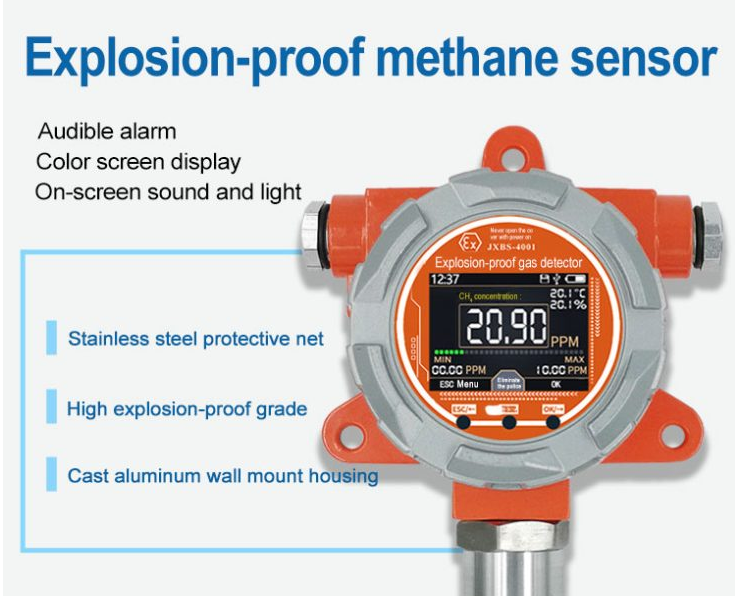Gas Detection Systems:
The gas detection system is meant to alert people to the presence of harmful gases such as carbon monoxide and combustible gases. If not detected early, it can cause injury or death. The gas detection system typically comprises sensors, alarms, and a control panel or meter. The detectors sense the presence of gases and communicate with the alarm, which alerts people in the area of the danger.

Gas detectors come in different types, including fixed and portable detectors. Fixed detectors work by continuously monitoring an area for the presence of hazardous gases, while portable detectors are handheld devices that emit alarms when they detect the harmful gas.
Four basic types of gas detection systems:
Explosion-proof CH4 gas sensor Fixed methane gas alarm detector
Catalytic Bead Detector
This type of sensor detects flammable gases using catalytic reaction. When a combustible gas comes into contact with the catalytic bead, it oxidizes, causing an increase in temperature. Then, the alarm sounded.
Infrared Sensor
This detector works by detecting differences in the absorption levels of infrared wavelengths between specific gases and confounding elements in the environment. It provides an accurate way of measuring carbon dioxide levels, volatile organic compounds (VOCs) and hydrocarbons.
Electrochemical Sensor
The electrochemical sensor detects toxic gases such as carbon monoxide, nitrogen dioxide, chlorine and hydrogen sulphide. It works by converting the targeted gas to an ion or molecule which can then be measured.
Photoionization Detector
This detector operates through breaking up molecules of gas by ultraviolet radiation hence creating ions. It can detect combustible gases at lower concentrations than most detectors.
Detecting Gas Leakage

Gas leakage can occur due to faulty piping, appliances, or facility equipment. Gas Detection systems usually detect specific odors, which are easy to identify. However, natural gas, propane, and methane are sometimes odorless, leading to difficulty in detection.
Unexplained instances of high gas bills, discoloration around pipes and fittings, reduced flame heights on burners are signs of potential gas leakage. Gas leaks can be diagnosed through leak detectors, ultrasonic leak detectors or soap bubble testing.
Leak Detectors: These come in both portable and fixed versions. Leak detectors work by measuring the concentration of a targeted gas near the test area.
Ultrasonic Leak Detection: These tools use ultrasonic waves to pick up sounds from gas leaks. The instruments pinpoint the leak’s location using sound technology.
Soap Bubble Test: this process involves applying pressurized gas to a suspect area and watching for any possible bubbles that may develop.
In addition to these diagnostic tools, visual inspection, smell tests, and even electronic leak detection methods can help detect leakage.
Precautions to take When Dealing with Gas Leaks
Gas leaks require prompt action to prevent potential bodily harm or property damage. Below are some precautions to take when dealing with gas leaks:
Evacuate immediately – If you suspect there is a gas leak, evacuate the premises/building immediately. Do not switch on or off any electrical appliances or make any phone calls. Avoid using your mobile phone and other electronic devices as they may cause sparks that could lead to an explosion.
Alert others – After evacuating, alert others in the area of the gas leak to prevent them from entering the premises.
Call emergency services – Once you’re outside the building, it is important to call the local fire department, police, and gas company to report the gas leak.
Don’t use open flames – Avoid using any open flames like lighters, matches, or cigarettes while near a suspected gas leak.
Ventilate the affected area – Provided there is no evidence of ignition, open all windows and doors to ventilate the area effectively.
Repair any underlying issues – Arrange for Professionals to diagnose and fix any underlying structural issues in your facility.
Regular check-ups and maintenance of Gas detection system – Only trust reputed companies for periodic repairs, maintenance services, calibration and training services when it comes to gas detection systems.
Conclusion
A gas detection system helps detect gas leaks and alerts individuals of their presence, making it easier for them to evacuate a building promptly. Individuals must take precautions when handling gas leaks and seek professional assistance to prevent the occurrence of future gas leaks.